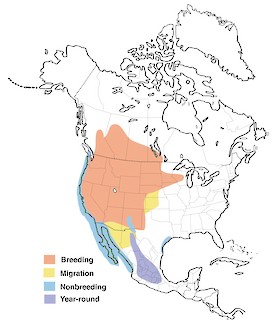Clark's Grebe Aechmophorus clarkii Scientific name definitions
- LC Least Concern
- Names (29)
- Subspecies (2)
Text last updated January 1, 1992
Sign in to see your badges
Species names in all available languages
| Language | Common name |
|---|---|
| Afrikaans | Geelbekdobbertjie |
| Azerbaijani | Klark batağanı |
| Basque | Clark murgila |
| Bulgarian | Жълтоклюн американски гмурец |
| Catalan | cabussó nord-americà carablanc |
| Croatian | žutokljuni gnjurac |
| Czech | potápka bělolící |
| Danish | Gulnæbbet Lappedykker |
| Dutch | Clarkfuut |
| English | Clark's Grebe |
| English (AVI) | Clark's Grebe |
| English (United States) | Clark's Grebe |
| Estonian | hele-suurpütt |
| Finnish | meksikonuikku |
| French | Grèbe à face blanche |
| German | Clarktaucher |
| Icelandic | Spjótgoði |
| Japanese | クラークカイツブリ |
| Norwegian | gulnebbdykker |
| Polish | perkoz żółtodzioby |
| Russian | Желтоклювая поганка |
| Serbian | Žutokljuni gnjurac |
| Slovak | potápka bielolíca |
| Spanish | Achichilique de Clark |
| Spanish (Mexico) | Achichilique Pico Naranja |
| Spanish (Spain) | Achichilique de Clark |
| Swedish | ljus svandopping |
| Turkish | Clark Batağanı |
| Ukrainian | Пірникоза Кларка |
Aechmophorus clarkii (Lawrence, 1858)
Definitions
- AECHMOPHORUS
- clarkii
The Key to Scientific Names
Legend Overview
Full content is available exclusively to Birds of the World subscribers. Sign in Learn more
Introduction
The Clark's Grebe is a conspicuous waterbird of western North America that ranges from extreme southern Canada to the Mexican Plateau. This species closely related to the Western Grebe (Aechmophorus occidentalis) and formerly classified as conspecific with it, in that Clark's was only a “white morph” of Western Grebe (but see Systematics History). Evidence for the renewed specific status of Clark's Grebe began with finding that Clark's and Western grebes mated assortatively (1), and an analysis of DNA-DNA hybridization (2) indicated that the median DNA sequence distance between the species was comparable to such distances between other congeners. Despite broad sympatry, intermediates (i.e., suspected hybrids) between the species apparently are rare, as are mixed pairings (1, 3); the species may interbreed as frequently as they do in areas of relative allopatry, implying adaptive mate choice (4).
Clark's and Western grebes are perhaps best known for their elaborate and energetic courtship rituals. These courtship ceremonies—in which courting pairs perform a series of displays in ritualized, apparently mechanical, sequences—are among the most complex known in birds. These two species are unique among grebes in possessing a mechanism in the neck that permits them to thrust forward the head like a spear. Such a mechanism is well known in herons (Ardeidae) and the anhingas (Anhingidae), but the details have not been studied in Aechmophorus grebes.
Because Clark's Grebe and Western Grebe were from 1886 until 1985 considered color phases of the Western Grebe, the literature on the two species was combined under that name. Only rarely was mention made of the “phase” of the birds studied. Because of this, and because of the great similarity between the two species in morphology and behavior, this account contains references that may pertain to both species. In the account, information known to apply specifically to the Clark's Grebe is given first, followed by information common to both species, and that for which the “phase” was not mentioned.
There are two subspecies of Clark's Grebe: A. c. transitionalis breeds in southwestern Canada and the United States, whereas A. c. clarkii is resident on the Mexican Plateau. Although the biology of the Clark's Grebe appears to be quite similar to that of the Western Grebe, Clark's Grebe is generally less numerous than the Western Grebe and has received much less study. Little is known about the biology of the Mexican subspecies.

- Year-round
- Migration
- Breeding
- Non-Breeding
Breeding occurs in widely scattered suitable bodies of water within this area.






















































